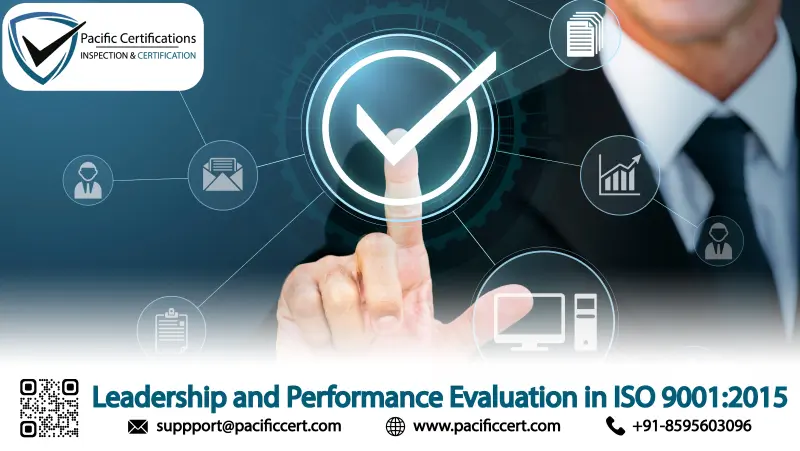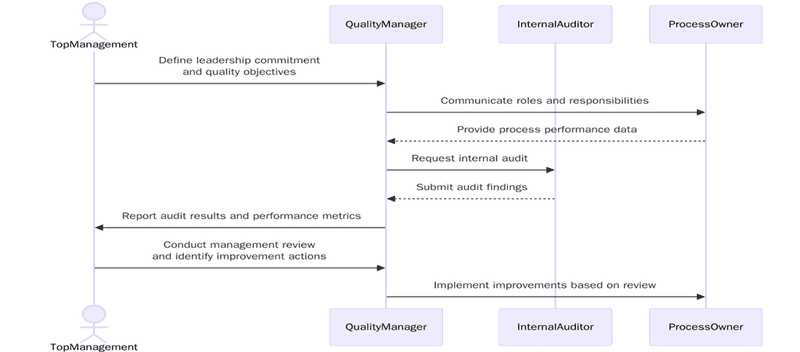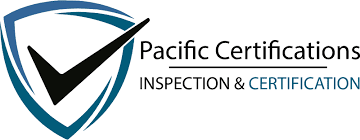Leadership and Performance Evaluation in ISO 9001:2015 Quality Management System

Introduction
Leadership and performance evaluation are two essential pillars of ISO 9001:2015 that define how organizations maintain consistent quality and drive continual improvement. This standard redefined the role of leadership from oversight to accountability, ensuring that top management actively integrates quality objectives into the organization’s strategy.
In today’s competitive environment, leadership involvement determines whether a quality management system (QMS) functions effectively or becomes a routine compliance checklist. Similarly, performance evaluation ensures that data-driven insights lead to measurable improvements in products, services and customer satisfaction.
Begin your ISO 9001 leadership and performance evaluation journey with Pacific Certifications, empowering organizations through globally accredited certification audits.
Quick summary
ISO 9001:2015 emphasizes a shift from management delegation to leadership engagement. Leaders are expected to demonstrate commitment, establish a clear quality policy, align objectives with strategic direction and promote a culture of continual improvement. Performance evaluation, meanwhile, ensures that these commitments are measured, analysed and improved through internal audits, customer feedback and management reviews. Together, they strengthen the QMS foundation and improve business sustainability.
Why leadership and evaluation matter in ISO 9001?
ISO 9001 recognizes that leadership drives quality culture. Without clear direction and accountability from top management, no amount of procedures can ensure consistent results. Performance evaluation, on the other hand, confirms whether quality goals are being met and where corrective actions are needed.
Through effective leadership, institutions establish purpose, align teams and foster responsibility. Performance evaluation adds measurable outcomes, helping leadership make data-informed decisions.
“Leadership commitment converts a documented QMS into a living system: one that measures, analyses and improves every day.”
Leadership and Performance Evaluation Overview in ISO 9001:2015
Clause | Focus Area | Leadership Role | Evaluation Method |
5.1 | Leadership and Commitment | Establish strategic direction, accountability and integration | Communication and policy alignment |
5.2 | Quality Policy | Create, maintain and communicate policy | Employee engagement and awareness surveys |
5.3 | Organizational Roles and Responsibilities | Define roles for quality outcomes | Role descriptions and delegation effectiveness |
9.1 | Monitoring, Measurement and Analysis | Use data to evaluate results and trends | Key performance indicators (KPIs) |
9.2 | Internal Audit | Verify process compliance and performance | Audit schedules and closure rates |
9.3 | Management Review | Review system effectiveness | Review minutes and action tracking |
What are the requirements for leadership and performance evaluation in ISO 9001?
Organizations must build clear accountability frameworks that define leadership responsibilities and performance review processes. Below are the primary requirements:

1. Leadership must align the quality policy with the organization’s direction.
2. Quality objectives must be measurable and consistent with customer expectations.
3. Top management must promote process-based thinking and risk management.
4. Define roles and authorities for all functions related to QMS.
5. Establish a framework for evaluating customer satisfaction and feedback.
6. Implement monitoring and analysis tools for key processes.
7. Conduct internal audits and management reviews at planned intervals.
8. Take corrective actions based on data insights.
9. Maintain documented evidence of review outcomes and improvement plans.
10. Ensure all results are communicated across the organization.
Tip:Link leadership KPIs (e.g., objective completion, employee training rate) with performance SLAs (e.g., audit closure within 30 days, customer complaint resolution time) for measurable accountability.
How to prepare for leadership and performance evaluation under ISO 9001?
Organizations preparing for certification or surveillance audits must ensure leadership involvement and system monitoring are fully embedded.
1. Conduct a leadership workshop on ISO 9001 roles and responsibilities.
2. Establish measurable quality objectives across departments.
3. Define KPIs for customer satisfaction, defect rates and process performance.
4. Review audit readiness and data collection procedures.
5. Implement management dashboards for performance tracking.
6. Schedule management review meetings quarterly or bi-annually.
7. Document results, actions and improvements systematically.
Certification audit
Stage 1 audit: Examines documentation, policies and leadership evidence.
Stage 2 audit: Reviews implementation, data collection and management review effectiveness.
Nonconformities: Must be corrected with proof of implementation.
Management review: Confirms leadership engagement and strategic focus.
Final certification: Granted after all requirements are verified.
Surveillance audits: Conducted annually to track sustained leadership involvement.
Recertification audits: Every three years to reaffirm continual improvement.
What are the benefits of leadership and performance evaluation under ISO 9001?
Integrating leadership and evaluation principles ensures the QMS is performance-driven and continuously improving. Below are the key benefits:
- Clear direction from leadership leading to consistent quality outcomes
- Improved data-driven decision-making through structured performance analysis
- Stronger communication between management and employees
- Increased accountability through measurable objectives and KPIs
- Greater customer satisfaction and trust in products and services
- Enhanced culture of continuous improvement across all departments
- Alignment of organizational goals with operational execution
- KPIs: customer satisfaction score, nonconformity closure rate, employee training hours
- SLAs: audit completion within 30 days, management review schedule adherence, action plan update frequency
Market Trends
Organizations are using real-time data visualization tools for performance monitoring. Leadership teams are integrating ISO 9001 metrics with ESG goals, ensuring transparency and sustainable governance. Digital dashboards track customer feedback, employee engagement and quality KPIs simultaneously, improving oversight.
By 2030, leadership accountability in ISO 9001 will extend to digital ethics, automation oversight and AI-driven decision-making. Performance evaluations will increasingly rely on predictive analytics, with quality systems identifying risks before they occur. Data-integrated audits will reduce manual intervention and improve system responsiveness.
Training and courses
Pacific Certifications offers accredited training programs for ISO 9001:2015:
1. Lead Auditor Training: For professionals conducting quality system audits and evaluating leadership effectiveness.
2. Lead Implementer Training: For managers responsible for integrating leadership and performance monitoring into daily operations.
Schedule ISO 9001 leadership training with [email protected].
How Pacific Certifications can help?
Pacific Certifications provides accredited ISO 9001 certification and audit services, focusing on leadership, quality objectives and system performance evaluation. Our audits assess management involvement, data analysis processes and improvement mechanisms.
We issue Certificates of Conformity following impartial, accredited audits, ensuring reliability without consultancy services.
Request your ISO 9001 leadership evaluation certification plan at [email protected] or visit www.pacificcert.com.
Ready to get ISO 9001 certified?
Contact Pacific Certifications to begin your certification journey today!
Author: Alina Ansari
Suggested Certifications –
Read more: Pacific Blogs
